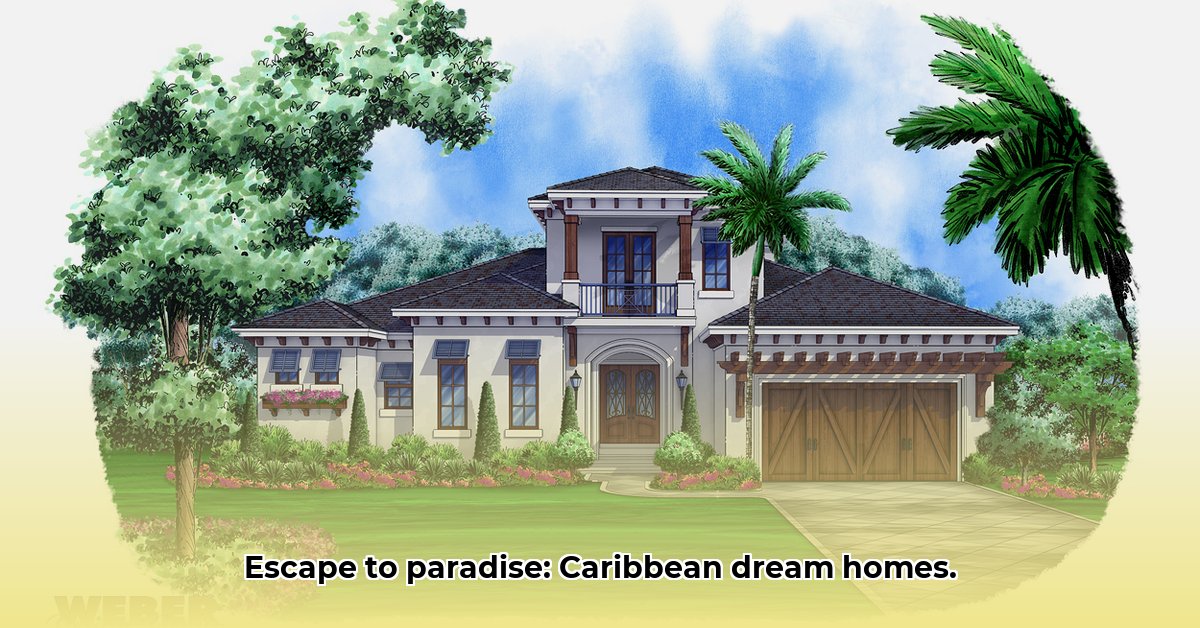Ever pictured yourself waking up in a Caribbean paradise in a home that’s both stylish and eco-friendly? This article explores the exciting world of modern Caribbean house design, focusing on cost-effective sustainability and resilient builds. We’ll dive into the latest trends – open-plan living, breezy outdoor spaces, and clever ways to use natural light. We’ll also discuss the materials used, the costs involved, and how to build sustainably in this unique climate. From stunning photos of real homes to practical advice for homeowners and builders, we’ll show you how to create your own slice of Caribbean heaven. For more inspiration, check out these modern house designs.
Modern Caribbean House Designs: Your Ultimate Guide to Island Living & Sustainable Building Materials
Dreaming of a Caribbean escape? Building your own home in paradise is more attainable than you might think, especially with innovative cost-effective design strategies. Modern Caribbean house designs offer a stunning blend of traditional charm and contemporary comfort, perfectly suited for the islands’ unique climate and laid-back lifestyle. Let’s dive into what makes these homes so special, including the resilient roofing systems able to withstand hurricanes.
A Blend of Island History and Modern Style: Architectural Sustainability
Modern Caribbean homes aren’t just pretty faces; they tell a compelling story. They beautifully weave together the region’s rich history—think elegant plantation houses with their wide verandas and soaring ceilings—with innovative, modern architectural trends. The result? Houses that are strikingly stylish and incredibly practical, perfectly adapted to the warmth and breezes of island life. You’ll find open floor plans that maximize air circulation and stunning views while maintaining a connection to the local architectural heritage. How can you integrate historic styles with modern sustainability requirements? Consider incorporating reclaimed materials from older structures into a new build or designing with passive cooling techniques that minimize the need for air conditioning, reducing energy consumption and honoring the past.
Historical Influences: Echoes of the Past & Hurricane-Resilient Design
The legacy of British West Indies architecture is unmistakable. Those classic plantation-style homes, with their grand proportions and breezy verandas, heavily influence today’s designs. This isn’t mere imitation; it’s a thoughtful reinterpretation. High-pitched roofs, for example, are a direct nod to these historic styles, providing natural shade and keeping interiors pleasantly cool. The orientation of buildings to capture prevailing trade winds, a common feature in historical designs, is also being revived to reduce reliance on air conditioning. This mindful blending of old and new creates homes that feel both timeless and fresh, authentically Caribbean yet undeniably modern.
Key Design Trends: Island Living Reinvented & Maximizing Ventilation
Current trends in Caribbean home design focus on maximizing the idyllic surroundings. Open floor plans are the norm, creating a seamless flow between indoor and outdoor spaces. Imagine waking up and stepping directly onto your veranda, the ocean breeze already greeting you. Large windows and doors—often floor-to-ceiling—flood the interiors with natural light, blurring the lines between inside and outside. Jalousie windows, adjustable to control airflow and light, are also making a comeback. Outdoor living areas are essential; think expansive patios, inviting verandas, and – of course – the pièce de résistance: a sparkling pool to cool off in the Caribbean sun. Consider incorporating outdoor kitchens, shaded dining areas, and even outdoor showers to fully embrace the island lifestyle while implementing eco-friendly architectural design.
Sustainable Materials: A Balancing Act of Beauty & Responsibility for Stucco Options
Building sustainably in the Caribbean presents unique challenges. The goal is to create homes that are kind to the environment without compromising aesthetics or durability. Light-colored stucco is a common choice, reflecting the sun’s heat and keeping interiors cooler. However, the environmental impact of cement production needs careful consideration. Locally sourced hardwoods offer stunning beauty and longevity, but ensuring their sustainable harvesting is crucial. Finding the right balance between eco-conscious practices and beautiful, long-lasting materials is a key consideration for modern Caribbean home builders. Ongoing research explores alternative, more sustainable construction materials and methods, promising even greener homes in the future. For example, bamboo, a rapidly renewable resource, is gaining popularity as a structural material and for interior finishes. Recycled plastics are also being used to create durable and weather-resistant decking and roofing materials.
Cost Considerations: Building Your Island Dream Affordably & Hurricane Protection
The cost of building your island dream home varies greatly, from budget-friendly options to luxurious villas boasting every imaginable amenity. The price depends heavily on factors like the size and complexity of the design, the materials chosen, and the location. Prime beachfront properties will naturally command higher prices. Careful planning and budgeting are essential to avoid unexpected costs and maintain structural integrity. Some experts suggest prioritizing your must-have features and finding creative ways to achieve a stylish, comfortable home without breaking the bank. This might involve carefully selecting materials, exploring less expensive alternatives without sacrificing quality, or phasing construction over time. For example, consider using locally sourced stone for landscaping instead of importing exotic materials. Or opt for energy-efficient appliances and solar panels to reduce long-term utility costs. Proper planning early on is vital.
Navigating Regulations: Building Codes and Climate Resilience & Government Incentives
Each Caribbean island has its own building codes and regulations, many of which are designed to ensure the resilience of homes in the face of natural disasters like hurricanes and flooding, including resilient roofing. These codes often specify requirements for wind resistance, seismic stability, and flood protection. In recent years, these codes have become stricter, reflecting increasing awareness of climate change and its potential impact. Government incentives often exist to encourage sustainable building practices, further influencing the design choices made by architects and homeowners. These incentives might include tax breaks for installing solar panels, rebates for using recycled materials, or grants for implementing water conservation measures. Staying informed about local building codes and regulations is crucial for a smooth and legally compliant construction process. Engaging a local architect or contractor familiar with the specific requirements of your chosen island is highly recommended. How will stricter building codes affect construction costs in the Caribbean? While initial costs might be higher due to the need for stronger materials and more robust construction techniques, the long-term benefits of increased resilience and reduced maintenance costs can outweigh the initial investment.
Case Studies: Island Homes that Inspire & Eco-Friendly Designs
Let’s look at a few real-world examples. Some architects are using innovative techniques to blend traditional Caribbean styles with cutting-edge sustainable materials, resulting in stunning homes that minimize environmental impact. One design might use locally sourced bamboo for structural elements, while another integrates passive cooling strategies to reduce reliance on air conditioning. For example, the use of green roofs, planted with native vegetation, can provide insulation, reduce stormwater runoff, and create a habitat for local wildlife. Another innovative approach involves using recycled shipping containers as building blocks for homes, offering a cost-effective and sustainable alternative to traditional construction methods. These examples highlight the creative solutions emerging in Caribbean architecture, showcasing the potential for beauty and sustainability to work hand-in-hand.
Materials Comparison: Weighing the Options & Hurricane Resistant Planning
Here’s a quick overview of common materials, weighing their pros and cons:
| Material | Pros | Cons | Sustainability Considerations | Hurricane Resistance |
|---|---|---|---|---|
| Light-colored Stucco | Heat reflective, low maintenance, cost-effective | Can crack if not properly applied, less character than other materials | Embodied carbon considerations due to cement production; explore alternative low-carbon options. | Moderate; requires proper reinforcement to withstand high winds |
| Local Hardwood | Durable, beautiful, locally sourced | Can be expensive, requires proper treatment to prevent decay, availability may be limited | Crucial to ensure responsible and sustainable forestry practices. | High, if properly treated and fastened |
| Concrete Tile | Durable, weather-resistant, long-lasting | Can be heavy, less aesthetically versatile than some other options | Significant embodied carbon, but long lifespan reduces overall impact. Consider recycled content options. | Very high, if installed correctly |
| Bamboo | Renewable, lightweight, strong | Requires treatment to prevent pests and decay, not suitable for all climates | Rapidly renewable resource, low embodied energy | Moderate; requires specific construction techniques |
The Future of Caribbean Home Design: Resilient Design & Building Techniques
The future of Caribbean architecture is likely to be shaped by a continued focus on sustainability and climate resilience. Architects and builders are constantly exploring new materials and construction techniques aimed at minimizing environmental impact while maximizing resilience to hurricanes and other natural events. Expect to see more homes utilizing passive cooling and solar energy, integrating seamlessly with their surroundings and reflecting an ongoing commitment to responsible development. Self-sufficient homes with rainwater harvesting systems and on-site waste treatment will become increasingly common. What new construction techniques show the most promise for a resilient and eco-friendly island home in the future? Insulated concrete forms (ICFs) offer excellent insulation and structural strength, while prefabricated modular construction can reduce construction time and waste. Bio-concrete, which incorporates bacteria to self-heal cracks, is also an exciting development with the potential to extend the lifespan of concrete structures.
The journey to building your Caribbean dream home is an exciting one. This guide provides a solid foundation, but remember to consult local architects and builders to navigate the specific regulations and opportunities in your chosen island location. Your island paradise awaits!
Comparing Caribbean Home Roofing Materials: Cost vs. Longevity & Weather Resistance
Building your dream Caribbean home? Roofing is a crucial decision. Let’s explore your options. Comparing Caribbean home roofing materials: cost vs. longevity is key to making the right choice, along with the resilience needed to withstand hurricane-force winds. How can you balance durability and affordability? Consider factors like wind uplift resistance, impact resistance, and resistance to salt spray and
- Glass Tile Shower Ideas to Create a Stunning Bathroom Space - December 7, 2025
- Glass Wall Tile Ideas for Kitchens and Bathrooms - December 6, 2025
- Glass Tile Bathroom: Create a Beautiful, Easy-Clean Space - December 5, 2025










